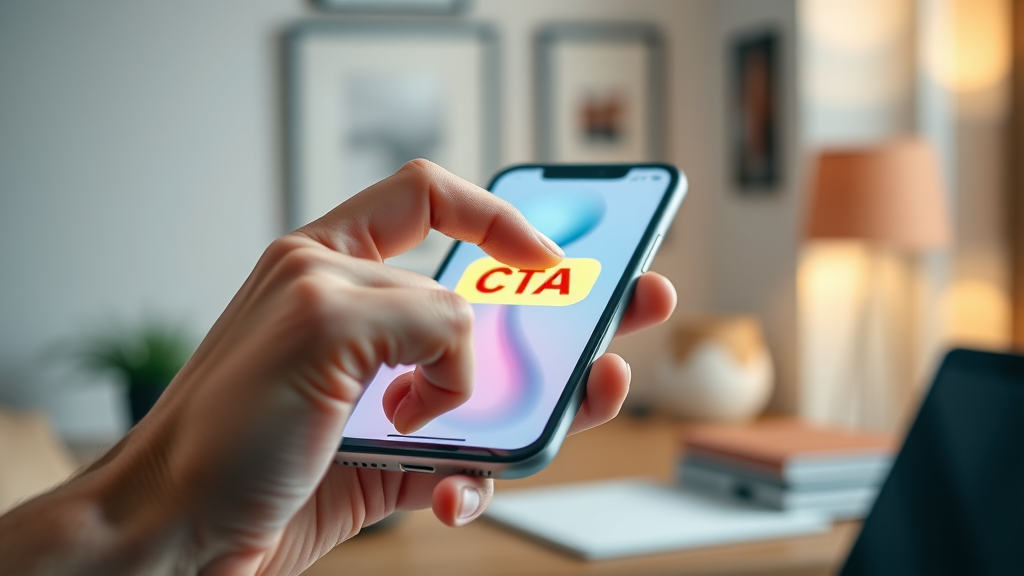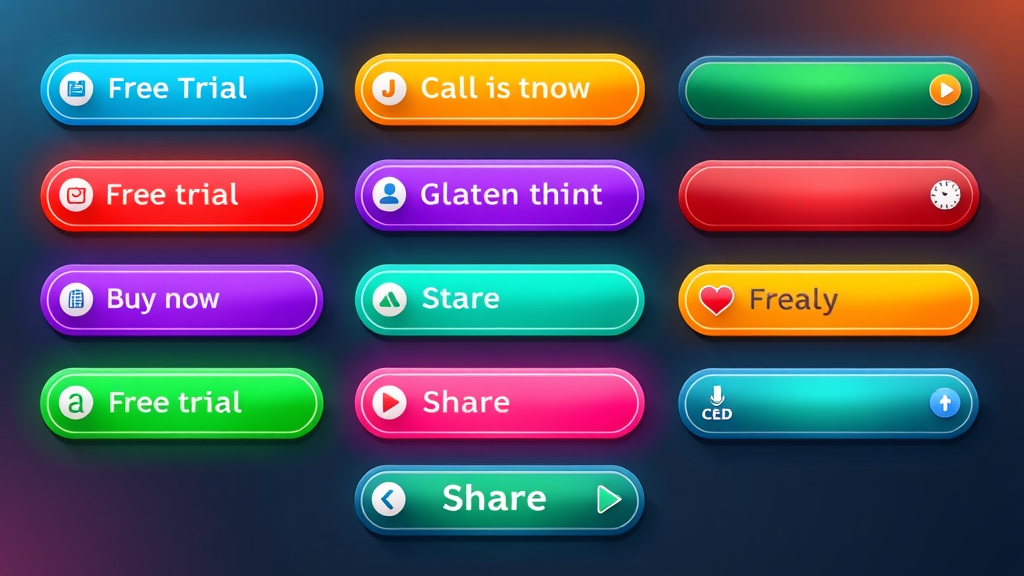Want to turn your website visitors into paying customers? That’s exactly what Call to Action (CTA) marketing is designed to do. Yet shockingly, 70% of small business websites lack a clear CTA on their homepage—meaning countless leads and sales vanish before they even begin. In this guide, we’ll break down how strategic CTAs—rooted in psychology, design, and placement—can drive your visitors to act, buy, and stay loyal.
Unlocking the Power of Call to Action Marketing: Why CTAs Make or Break Your Campaign
Did You Know?
“70% of small business websites lack a clear call to action on their homepage. Imagine the conversions missed!”

Why call to action marketing is the linchpin for high-performing digital campaigns
How calls to action guide your target audience toward desired actions and increase your conversion rate
Call to action marketing is the secret ingredient in converting web traffic into measurable business growth. Imagine a visitor lands on your website, interested but unsure where to go next. Without a strong, visible CTA, their journey ends in confusion—a lost opportunity. On the flip side, when you deploy targeted calls to action across your digital landscape, you guide visitors purposefully toward desired actions , such as completing a purchase, signing up for a free trial , or following your brand on social media .
Effective CTAs are central to improving your conversion rate across every marketing campaign . Whether you’re driving lead generation through newsletter signups, spurring instant action with urgency-driven cta buttons , or nudging readers to share your latest blog post , the quality and placement of your CTAs shape every step of the funnel. The absence of strategic calls to action leaves even the best-designed landing page feeling aimless—don’t leave your potential customers guessing!
What You Will Learn About Call to Action Marketing and Calls to Action
The psychology behind effective call to action marketing
Best practices for designing cta buttons and cta copy
Types of ctas and how to match them with your target audience
How to write and place calls to action for maximum conversion rate
Real-world cta examples that drive results
FAQs and resources to implement powerful call to action marketing

What is a Call to Action in Marketing? Decoding the Core of Call to Action Marketing
Defining Calls to Action for Beginners and Pros
What does a call to action accomplish in a digital strategy?
Why call to action marketing is an essential conversion rate lever
At its core, a call to action (CTA) in marketing is a direct prompt urging your target audience to take the next logical step. This can range from clicking a “Buy Now” cta button to filling out a form for more contact information . Much more than simple text or colored buttons, a strong CTA is woven throughout the customer journey—from your landing pages and emails to every blog post and social media update.
The primary purpose of calls to action is to encourage users to complete a desired action . Without a CTA, even well-crafted marketing material becomes passive, providing information but failing to convert. In contrast, effective call to action marketing drives your conversion rate by offering clear instructions—compelling your audience to act now rather than later.
Comparison of Call to Action Types by Campaign Goal | ||
Type of CTA |
Campaign Goal |
Example |
|---|---|---|
Lead Generation |
Grow email list, collect info |
“Sign Up for Free Tips” |
Sales |
Boost revenue via purchases |
“Buy Now”, “Add to Cart” |
Brand Awareness |
Expand audience reach |
“Share on Social Media” |
Engagement |
Encourage user interaction |
“Comment Below” or “Read More” |

The Science Behind Effective Call to Action Marketing: How CTAs Influence Behavior
Understanding the psychology of cta buttons and sense of urgency

Behavioral triggers that propel users to act
“A compelling CTA can lift conversion rates by up to 285% when paired with urgency or FOMO.”
A good cta doesn’t just sit on a page—it encourages users to make snap decisions by tapping into core human motivators. Psychological principles like a sense of urgency (“Limited Time Offer!”) and FOMO (fear of missing out) increase desire for instant gratification. Elements such as bold colors, prominent placement, and persuasive cta copy draw attention and subtly guide users toward conversion.
Understanding how users process information on a web page is key. Effective CTAs use contrasting colors, active verbs, and even motion to interrupt browsing inertia and direct attention. Split tests consistently show that a well-placed, carefully worded cta button can substantially increase conversion rates —often making the difference between a bounce and a buy.
Incorporate behavioral triggers—such as exclusivity (“Members Only”), personalization (“Recommended For You”), and curiosity (“See What’s Inside”)—to nudge your target audience into action. The right mix of emotional triggers, design, and clarity in your call to action marketing captures fleeting user attention and turns it into measurable action.
Best CTA Examples: Learning From High-Performing Calls to Action
Action Examples That Convert
Real-world cta examples from e-commerce, SaaS, and service sites
Analysis: Why were these calls to action successful?

Let’s explore some ctas that consistently outperform the competition. On e-commerce platforms, brightly colored cta buttons like “Add to Cart” or “Checkout Now” simplify the buying process and use action verbs that tell the user exactly what will happen next. SaaS companies often tap into free trial offers—like “Start 30-Day Free Trial”—reducing perceived risk and giving visitors a reason to act immediately.
Service websites commonly employ urgency and benefit-focused cta copy , like “Book Your Consultation Today” or “Unlock 20% Off—Join Now.” The highest-converting CTAs are clear, specific, and use action-oriented language that matches the intent of the landing page . These cta examples work because they resonate with the user’s needs, promise rapid value, and are visually easy to find.
Types of Calls to Action for Every Business Goal
Lead generation ctas: Free trial, newsletter signup
Sales cta buttons: Buy now, add to cart
Engagement ctas: Read more, share on social media
Top 10 Types of CTAs with Example Copy and Use Cases | ||
CTA Type |
Example Copy |
Best Use |
|---|---|---|
Free Trial |
“Try Free for 14 Days” |
Software/SaaS Lead Generation |
Buy Now |
“Buy Now”, “Add to Cart” |
E-commerce Sales |
Subscribe |
“Subscribe Now”, “Get Updates” |
Newsletter/Email List Growth |
Download |
“Download Your Guide” |
Lead Magnet/Whitepaper |
Contact Us |
“Contact for Demo” |
B2B Service/Consulting |
Share |
“Share This Post” |
Social Media Engagement |
Learn More |
“Discover How”, “Learn More” |
Awareness Landing Pages |
Save/Claim Offer |
“Claim Your Discount” |
Promotional Campaigns |
Start Now |
“Start Now”, “Get Started” |
App Installs, Quick Signup |
Join Community |
“Join Our Community” |
Brand Loyalty Social Groups |

Designing Compelling CTA Buttons for Call to Action Marketing
Elements of a High-Performing CTA Button
Color, size, and placement strategies for effective cta buttons

Designing a high-performing cta button goes beyond just picking a bright color. The most effective ctas use size, shape, and placement to draw the user’s eye and make the next step obvious. Color should contrast with the background without clashing, helping the cta button stand out without overwhelming the page. F-pattern and Z-pattern layouts also dictate where users are most likely to notice your CTAs, especially on landing pages .
Testing: Split-testing cta button variations to boost conversion rate
Case studies: How button design increased conversions
A/B testing is essential to refine cta buttons —sometimes a small tweak delivers a huge spike in conversion rates . For example, changing “Submit” to “Get My Free Ebook” clarified the benefit and doubled conversions on one content download page. Case studies have also shown that shifting button placement closer to premium content in a blog post raises both scroll depth and user actions.
Crafting Irresistible CTA Copy
Copywriting secrets: Action verbs, clarity, and specificity
Examples of high-performing cta copy for blog posts and social media
“Simple, concise CTA copy outperforms complex language by 45% in A/B testing.”
A compelling cta starts with compelling cta copy . Action verbs like “Download,” “Start,” or “Join” front-load the call with clarity and urgency, while details like “Free Trial” or “Instant Access” tell users what they’re getting. Good CTAs avoid generic phrases—replace “Submit” with “Claim Your Free Demo,” or “Next” with “Download Your Guide.” Especially on blog posts and social media , short, punchy copy tailored to the context performs best.
When crafting cta copy for blog posts , encourage engagement with invitations like “Leave a Comment Below” or “Share This Story on Facebook.” For social media , offer incentives: “Tag a Friend Who Needs This!” or “Double Tap If You Agree.” Each phrase should answer a user’s unspoken question—“What’s in it for me?”—and remove hesitation with clarity.
Targeting Your Audience: Personalizing Calls to Action for Maximum Conversion Rate
Segmenting audiences for more relevant calls to action
Using dynamic content and behavioral data to tailor cta marketing

Why personalization increases the effectiveness of cta buttons
Personalization is a game changer in call to action marketing . By segmenting your target audience based on behavior, interests, or past interactions, you can show the right call to action at the right moment. Tools like dynamic content and behavioral data let marketers display different CTAs to different users—perhaps offering a discount to returning visitors or highlighting a free trial for first-timers.
Personalized cta buttons drive higher engagement and conversion rates because they feel more relevant and timely. For instance, if analytics show a user frequently visits a pricing page, surfacing a “Request a Custom Quote” CTA can capture intent before they leave. This targeted approach not only enhances the user experience but also maximizes the ROI of each marketing campaign .
Sense of Urgency in Call to Action Marketing: How to Drive Faster Decisions
Incorporating urgency and scarcity into your call to action marketing
Phrases that prompt immediate action
Examples and split-test insights on urgency-driven cta buttons

Urgency and scarcity are proven psychological levers in call to action marketing . Phrases like “Only 3 Left!” or “Offer Ends Today” trigger a sense of urgency , prompting users to act before missing out. Integrating visual cues—such as countdown timers near a “Register Now” button—further amplifies this effect, as seen in countless high-performing landing pages and e-commerce checkouts.
A/B tests show that adding urgency to cta buttons can more than double your conversion rate . Common winning phrases include “Get Instant Access,” “Limited Spots Available,” or “Claim Your Spot Before Midnight.” Analyze your data to identify where hesitation occurs, and experiment with time-sensitive offers to accelerate decisions.
CTAs Across Platforms: Optimizing Calls to Action on Social Media, Email, and Blog Posts
Social Media Call to Action: Keys to Virality
Best practices for cta buttons and cta copy on Facebook, Instagram, Twitter/X

On social media , cta copy must be thumb-stopping and platform-appropriate. Facebook users respond to direct prompts like “Shop Now,” Instagram loves “Swipe Up to Learn More,” while Twitter benefits from urgent CTAs such as “Retweet If You Agree.” CTAs perform best when integrated naturally into post visuals and paired with incentives, like exclusive discounts or downloadable resources.
Monitor which types of ctas resonate with each audience, and change up your approach as algorithms and user behaviors evolve. For example, carousel posts work well with “Explore More,” while Stories favor time-bound language such as “Last Chance!”
Email Marketing: Optimizing CTA Placement and Wording
Headline-honed cta examples that entice opens and clicks
In email marketing , the placement and wording of your CTA can make or break your campaign. Ensure your cta button is visible above the fold, uses high-contrast color, and leverages urgent, benefit-focused language. Subject lines like “Unlock Your Discount—Today Only” complement prominent CTAs such as “Get My Savings” within the email body.
Test both single and multiple cta approaches—sometimes one clear instruction works best, while other campaigns benefit from secondary CTAs (“Download Guide” and “Contact Support”). Always track open and click rates, and refine wording for clarity and relevance.
Blog Post CTAs: Turning Readers Into Leads
Content upgrades, comment prompts, and shareable ctas
Every blog post should work as a gateway to deeper engagement. Use CTAs like “Download the Free Checklist” or “Leave a Comment Below” to turn passive readers into active subscribers. Place CTAs within the content (mid-article banners), in the sidebar, and at the end—each optimized for context and user intent.
Encourage sharing with “Tweet This Quote” or “Share with a Friend” buttons. Content upgrades (like bonus PDF downloads) are especially effective at capturing emails and nurturing leads directly from educational posts.
Testing and Measuring Call to Action Marketing Performance
Essential Metrics: How to Track and Improve CTA Conversion Rate
Key Metrics for Call to Action Marketing Success | ||
Metric |
Definition |
Why It Matters |
|---|---|---|
Click-Through Rate (CTR) |
% of users clicking the CTA |
Shows CTA effectiveness at capturing attention |
Bounce Rate |
% of users leaving after viewing one page |
Indicates misalignment between CTA and content |
Conversion Rate |
% of users completing the desired action |
Measures overall campaign success |
A/B Split Results |
Comparisons between different CTA versions |
Finds high-performing copy/design |
Tools for tracking calls to action performance and iterating on CTA strategies

No call to action marketing strategy is complete without rigorous measurement. Track essential metrics such as click-through rate (CTR), bounce rate , and ultimate conversion rate to gauge effectiveness and identify bottlenecks. Modern tools like Google Analytics, Hotjar, and Optimizely let you follow user paths, test cta button variations, and report on what actually moves the needle.
Iterate by split-testing both cta copy and design. For instance, try alternating between benefit-driven wording (“Get Free Access”) and action-oriented phrasing (“Start Now”) or varying button colors. The data you collect provides a clear roadmap for ongoing improvements—and ongoing conversion lifts.
Common Mistakes in Call to Action Marketing and How to Avoid Them
Overused phrases, weak cta copy, and lacking urgency
Design pitfalls in cta buttons
List: Troubleshooting underperforming calls to action
Even experienced marketers fall into classic CTA traps. Avoid generic, uninspiring phrases like “Click Here” or “Submit”—these fail to communicate benefits or inspire action. Weak, low-contrast cta buttons often blend into the background, making them easy to miss. Many web pages suffer from too many competing CTAs, confusing users and diluting impact.
Common design pitfalls include poorly chosen colors, tiny button sizes, or placing CTAs too far down the landing page for users to notice. Always prioritize clarity, contrast, and clear hierarchy in your marketing materials . If a CTA underperforms, troubleshoot with this quick list:
Is the CTA specific and benefit-focused?
Does the button stand out visually?
Is there a clear incentive or urgency?
Have you tested alternative wording and placement?
When in doubt, let your target audience guide your CTA strategy—user feedback and analytics often reveal the simplest fixes.
Expert Insights: Quotes from Conversion Rate Optimization Leaders on Call to Action Marketing
“If your CTA is an afterthought, your conversion rate will reflect it. Make it the centerpiece.”
“The best CTAs are born from understanding what your audience wants, not just what you want them to do.”
Frequently Asked Questions on Call to Action Marketing
What is a call to action in marketing?
A call to action in marketing is a prompt that directs your target audience to take a specific next step, such as buying, signing up, or learning more, and is the core mechanism in call to action marketing for driving conversion rate.
What is an example for call for action?
Clicking a 'Start Free Trial' cta button, subscribing to a newsletter, or following on social media are action examples of calls to action in digital marketing.
What is a call to action statement example?
An example of a call to action statement is: “Get instant access—Sign Up Now!” or “Download Your Free Guide”.
What is Nike's primary call to action?
Nike’s primary call to action varies by campaign but often features direct action examples like “Shop Now” or inspirational CTAs such as “Just Do It.”
Resource List: Must-Have Tools for Call to Action Marketing Success
List of top tools for a/b testing, cta button design, analytics, and copywriting
Links to cta generators, usability checkers, and inspiration libraries
Maximize your call to action marketing with tools like Optimizely (A/B testing), Unbounce and Leadpages (landing page and CTA button design), Hotjar for behavioral analytics, Canva and Figma for creating high-converting button graphics, and Copy.ai or Jasper for proven cta copy . For ideas and templates, visit CTA generator sites and usability libraries like Really Good Emails or CallToActionExamples.com.
Video: How to Craft the Perfect CTA for Maximum Conversion Rate
Tutorial demonstrating the anatomy of a great cta button and real-world cta examples
Watch an in-depth walkthrough on building powerful, visually engaging CTAs that boost your conversion rate—complete with actionable steps and before-and-after case studies of successful call to action marketing.
Video: Call to Action Marketing Case Studies – Real Brands, Measurable Results
Before-and-after cta marketing results and interviews with CRO experts
Explore real stories of brands that transformed their metrics by optimizing CTAs, featuring expert interviews and original case studies that reveal specific tactics for seamless execution.
Video: Common Mistakes in Calls to Action and How To Fix Them
A walkthrough of poor and effective calls to action, with tips for immediate improvement
Watch this step-by-step guide diagnosing weak CTAs, explaining design and copy blunders, and giving actionable fixes you can implement in your next marketing campaign .
Take Immediate Action: Your Next Step in Call to Action Marketing
Ready to supercharge your marketing conversions with stronger calls to action? Call Digital Media Marketing at 586-997-0001 to schedule your free consultation today.
Take action: Audit your cta buttons, test new copy, and contact a specialist to maximize conversion rates with strategic call to action marketing.
 Add Row
Add Row  Add
Add 




Write A Comment